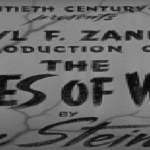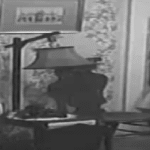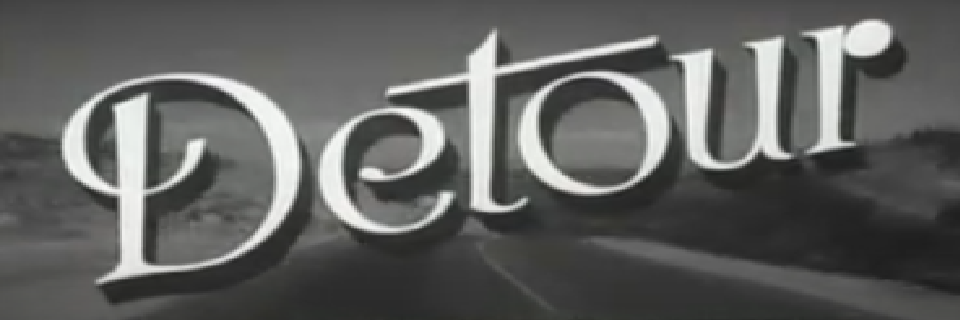Detour, a low-budget American film noir released in 1945, is a haunting, compact tale that draws the viewer into a murky world of fate, fatalism and chance. Directed by Edgar G. Ulmer and starring Tom Neal and Ann Savage, the film’s stripped-down style, raw energy and dark atmosphere mark it as one of the grittiest and most effective entries in the noir canon. Its narrative unfolds like a fever dream, told through a haze of memory and regret, with its unreliable narrator pulling the audience into a spiral of doom from which there is seemingly no escape.
The story centres around Al Roberts, a down-on-his-luck pianist in New York, who finds himself spiralling into misfortune after deciding to hitchhike to Los Angeles to join his girlfriend Sue. She has left for the West Coast in pursuit of a singing career, and Al, discontent with his meagre earnings and lonely without her, decides to follow her. It’s this seemingly simple, if impulsive, decision that sets the entire chain of events into motion.
From the very start, Al’s narration casts a shadow over the proceedings. He recounts the events from a dingy diner, his voiceover laced with bitterness and resignation. His tone makes it clear he sees himself as a victim of cruel fate, a man who simply couldn’t catch a break. This perspective shapes the entire film, colouring it with a strong sense of inevitability and doom. The viewer is never entirely sure whether Al is telling the truth, whether he is omitting details, or whether he even sees things clearly himself.
As Al makes his way westward, he is picked up by a gregarious but secretive man named Charles Haskell Jr., who is heading to Los Angeles. Haskell is friendly enough, and the two strike up a casual rapport, though Al remains wary. Then, in a sudden and eerie turn, Haskell dies — apparently of natural causes, possibly exacerbated by medication and the stress of driving. Al, gripped by panic and fear that no one would believe he had nothing to do with Haskell’s death, decides to dispose of the body and assume the dead man’s identity, using his car and money to continue his journey.
This decision, made in a moment of desperation, seems to cement Al’s fate. He has now crossed a moral line, even if he has not yet committed a crime in the strictest sense. It is at this point that the film introduces its most unforgettable character — Vera. Al picks her up on the roadside, only to discover she had earlier travelled with Haskell and quickly realises Al is not who he claims to be. Vera is brash, cynical and razor sharp, and she immediately takes control of the situation, blackmailing Al into compliance.
Vera is a force of nature, a femme fatale who is not motivated by seduction but by anger and self-interest. Unlike many women in noir, she doesn’t flirt or tease — she barks orders and threatens. There is no glamour or mystery to her, only raw desperation. She proposes that they sell Haskell’s car and belongings, but then hatches a more daring plan: to impersonate Haskell’s heir in order to inherit his father’s estate. Al is sickened by the idea, but Vera manipulates him into going along with it, hinting that she may turn him in otherwise.
Their relationship quickly deteriorates. Trapped together in a dingy Los Angeles apartment, their interactions are tense, hostile and laced with mutual distrust. The claustrophobic setting and Vera’s caustic presence weigh heavily on Al. Eventually, after a drunken argument, Vera ends up dead — strangled accidentally when Al tries to yank the telephone cord away from her to stop her calling the police. It’s a horrifying moment, but one presented as a tragic accident, at least from Al’s perspective.
Now implicated in two deaths and with no one to vouch for his innocence, Al descends into full despair. The film ends where it began, with Al sitting in a diner, recounting the chain of events that led him to this point. He imagines being caught by the police and resigns himself to the idea of justice, however unjust it may feel. The film closes not with hope or redemption, but with a sense of grim fatalism — the idea that once you make one wrong turn, you can never get back on course.
The narrative structure of Detour is notable for its use of flashback and voiceover, two devices that heighten the subjectivity of the story. Al’s recounting of events may be sincere, but he is not a trustworthy narrator. The viewer is left to wonder whether the deaths he describes were truly accidental or whether his memory has filtered the events through a lens of self-preservation. This ambiguity is central to the film’s power. It forces the audience to sit with uncertainty, much like Al himself.
Stylistically, the film’s limitations in budget become part of its atmosphere. The minimal sets, harsh lighting and abrupt cuts contribute to a sense of unease and dislocation. There is no glamour to Detour, no polished sheen. It is grimy and bleak, reflecting the moral quagmire in which its characters operate. Tom Neal’s performance as Al is subdued and plaintive, lending the character a mournful air. Ann Savage, on the other hand, delivers a ferocious turn as Vera, whose scornful glances and cutting remarks make her one of the most unforgettable figures in noir history.
The film’s enduring legacy lies not just in its taut storytelling or unforgettable characters, but in its embodiment of noir’s darkest themes: moral ambiguity, the inescapability of fate, and the peril of ordinary people caught in extraordinary circumstances. It suggests that a single decision, made under pressure, can unravel a person’s life entirely. There are no heroes in Detour, only people swept along by forces they neither understand nor control.
In just over an hour, Detour paints a devastating portrait of a man who tries to outpace his misfortunes but finds himself trapped by them instead. The film’s simplicity is deceptive — beneath its spare structure lies a rich meditation on guilt, chance and the stories we tell ourselves to survive. It remains a harrowing journey into the heart of noir and a testament to what can be achieved with minimal means and maximum conviction.







